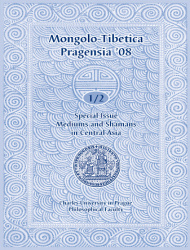MONGOLO-TIBETICA PRAGENSIA '08, Ethnolinguistics, Sociolinguistics, Religion and Culture. Vol. 1, No. 2. 2008

Editors-in-chief: J. Vacek and A. Oberfalzerová
Triton, Praha 2008, 207 pp.
ISSN 1803-5647
Editorial Board:
Daniel Berounský (Charles University in Prague)
Katia Buffetrille (École pratique des Hautes-Études, Paris)
J. Lubsangdorji (Charles University Prague)
Marie-Dominique Even (Centre National des Recherches Scientifiques, Paris, France)
Tsevel Shagdarsurung (National University of Mongolia, Ulaanbaatar, Mongolia)
Domiin Tömörtogoo (National University of Mongolia, Ulaanbaatar, Mongolia)
Institute of South and Central Asian Studies, Seminar of Mongolian Studies
Faculty of Arts, Charles University in Prague
Celetná 20, 116 42 Praha 1, Czech Republic
http://mongolistika.ff.cuni.cz/
Published by Triton
First edition, Praha (Prague) 2008
ISSN 1803-5647
Registration number of MK ČR E 18436
The publication of this journal was financially supported by the Ministry of Education of the Czech Republic as a part of the Research Project No. MSM0021620825 “Language as human activity, as its product and factor”, a project of the Faculty of Philosophy, Charles University in Prague.
For acquisition please contact
Contents:
Katia Buffetrille (École pratique des Hautes-Études, Paris):
Some remarks on mediums: The case of the lha pa of the musical festival (glu rol) of Sog ru (Amdo)
This paper deals with a festival (glu rol) dedicated to the local gods (yul lha gzhi bdag)that takes place every year during the sixth Chinese lunar month (July–August) in about fifteen villages in Reb gong area (A mdo, present Qinghai province). It is performed by the villagers in order to get prosperity and good fortune and to drive away calamities. The central personages of this celebration are mediums (lha pa). The article presents the translation from Tibetan of an article on this celebration followed by preliminary remarks on the lha pa and an attempt at interpretation of this festive ritual. The author argues that this ritual aims at restoring the order the world through the activities of the lha pa/gods, their “servants” and their helpers.
Daniel Berounský (Charles University, Prague):
Powerful Hero (Dpa’ rtsal): Protective Deity from the 19th century Amdo and his mediums
The text follows the history of the protective deity from North-Eastern Tibet (Amdo). It starts with the story on his origin, which explains how hermit Sangye Yeshe became a demon after his passing away and was then ritually tamed by the 8th Kirti master in the late 19th century. The taming is described as “raising him to the rank of deities” and after then he became personal protector of Kiirti masters. At the same time he played a significant role in converting the local people from the Bon religion to the Gelugpa version of Buddhism. His forceful nature surfaced in connection with the local conflict between Gelugpa monasteries in Amdo. But recently he also became involved in the so-called “Shugden affair” and used as antidote to this deity, which was recently banned by official circles in Dharamsala. From the beginning of the 20th century he possessed mediums in the Kirti monasteries of Ngawa and Tagtshang Lhamo. To the last medium “the door of the deity was opened” only in the year 2000 and the process during which the medium of the deity was recognized as a “reincarnation” is traced back in this paper in some detail.
Ha Mingzong (Charles University, Prague) – Charles Kevin Stuart (Independent scholar): The return of the Goddess: Religious revival among Hawan village Mongghuls
Revival of religious practice related to the clan goddess of the Monggghul (Tu) of Hawan Village, Tiantang Township, Tianzhu Tibetan Autonomous County, Gansu Province, PR China is examined, chiefly by giving detailed accounts from the villagers. Specifically, we describe the movement of the Hawan Mongghul from the contemporary Huzhu Mongghul Autonomous County, Haidong Region, Qinghai Province to their current home; Heavenly Mule King (Luozi Tianwang) and his deity-medium (fala) that possessed the body of his medium (fala) Ha Chengshan (Ha Nangsuo (1880/ 1881–1948) who thus could meet many of the spiritual needs of the local people; Ha Chengshan’s refusal to willingly be a medium for this deity; and Hawan villagers a half-century later, building a shrine for their clan goddess – Niangniang.
Veronika Zikmundová (Charles University, Prague): Walking on the edges of swords: Notes on analogies in shaman rituals of the Khorchin Mongols and the Jungarian Sibes
Before the 17th century the Sibes lived as vassals of the Khorchin Mongols. Both Khorchins and Jungarian Sibes are known as ethnic groups with living shamanic practices. When comparing their shaman traditions, it is useful to refer to the numerous and intertwined analogies between the two cultures. This idea is further supported by linguistic material. Using mainly the available folklore materials the present paper draws a comparison between different parts of the traditions, in particular those connected to the trial-rituals and deities important in the rituals. Generally, many ‘enigmatic’ features in the Sibe shaman tradition (as well as other parts of the culture) can be explained through Mongolian influence, and sometimes Mongolian culture can also be explained through Sibe tradition.
Rachel Mikos (Charles University, Prague) – Martin Tharp (Prague University of Economics): From the English Garden to the Ob: The life and work of Vilmos Diószegi
The present article concerns the scholarly work and life of Hungarian anthropologist Vilmos Diószegi (1923–1971), one of Europe’s foremost researchers on shamanism in northern and central Asia. In particular, emphasis is placed on the relationship between personal experiences and intellectual legacy within Diószegi’s career, focusing on the theoretical questions of hermeneutic suspicion with regard to the observer in the social sciences, as well as the vexed question of anthropological and ethnographic investigation within the systems of European nationalism and Soviet communism. Based largely on Diószegi’s quasi-popular narrative Sámánok nyomában Szibéria földjén [In the Steps of the Siberian Shamans] and his recently published diaries and letters, the article examines the key forces shaping his scholarly practice, specifically Hungarian nationalist origin-mythology and Soviet nationalities policy, during the course of his travels collecting information on the last shamans in Siberia and Tuva.

